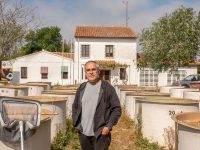
 |
||
|
Galileo and the Telescope. Knowing and Seeing. Un dì all’azurro spazio guardai profundo
Above, Galileo’s Sidereus Nuncius published in 1610 on the occasion of his first astronomic observations with a telescope. Below, drawings of the Moon made by Galileo and published in Sidereus Nuncius.
■ the invention of the telescope Spirits were high at the beginning , but not everyone shared Galileo’s enthusiasm. On the contrary, he had many adversaries that tried to defend traditional astronomy and cosmology at all costs. They first tried to accuse Galileo of plagiarism. He never claimed to have invented the telescope —which back then had many different names—, but, having heard of it, he had built one himself. That happened in the summer of 1609. In fact, for more than a year, word was out in Europe that a strange artefact that aided in the observation of remote objects had been invented. A Dutch spectacle maker, Hans Lipperhey, presented it to Maurizio de Nassau and expected to register it, but the committee designated to examine the object rejected the request claiming that the invention was of public domain. Indeed, the telescope was sold in different European cities for a few coins, and for instance, in October 1608, cardinal Guido Bentivoglio got one that months later gave as a gift to cardinal Scipione Borghese. What is more, now we know that the Dutch spectacle maker Johannes Sacharias made the first telescope in his country in 1604, imitating one coming from Italy that had inscribed: year 1509 (Ronchi, 1958). But what is important is that almost every object of this kind were just trinkets. In August 1609, Giovanni Batista della Porta, possibly more a magician than a spectacle maker, affirmed that the secret of the occhiale is a coglionaria, and it is taken from my book 9 of De refractione (Opere, x: 252). So, in 1609, the invention was almost two decades old and many people claimed their authorship, but nobody took these claims seriously. Not even Kepler, who had developed some theoretical aspects that were possibly just enough to explain the telescopic combination of lenses (Optica, 1604), paid any attention to the telescope until Galileo presented it together with his astronomic observations. Galileo explained twice that he had made it by deduction from optical theory, but the truth is that he always kept in the setting of the futile traditional optical theory and went on talking indistinctly about species –or image of things–, visible rays and luminous rays that get to the eye through the visual pyramid with base in the object seen and the vertex in the lens of the eye. In fact, he took the trouble to engage in the optical-theoretical debate. What Galileo made and described is a simple reasoning that led him to combine, at the ends of a lead tube, two lenses, a flat-convex lens (objective) and a flat-concave lens (eyepiece), and not two convex lenses, like Kepler did later on when he built his «astronomy telescope» from this theory. In this sense, that they were sceptical about the wonders this new instrument was able to do was understandable. Moreover, optics was a paradigmatic field of the unreliability of senses: certain glasses, lenses and mirrors deformed reality, making see things in a different way. Galileo took for granted the use of the telescope, the issue at stake was choosing between faulty telescopes, as most were, or good telescopes, well made telescopes that faithfully showed the truth without adding nothing to reality. His technical ability was admirable. He often polished the lenses and, in an industrious and intelligent process of trial and error, he built dozens of telescopes, each one better than the previous one. From the top of San Marco’s bell-tower, he made people see buildings of nearby towns, like Treviso and Conegliano, people getting in or out of church, and ships arriving into the shore, which were not visible until two hours later. He was appointed full professor of the University of Padua and got a considerable salary increase. ■ Galileo’s observations But, leaving economic or military interests aside, Galileo used the telescope for astronomical observation, something that nobody had done before, and it was something revolutionary. Between December 1609 and January 1610, his activity was frenetic. During the day he polished lenses and during the night he made astronomical observations. Every time he looked up the sky he made an important discovery. The moon was like another Earth through the telescope: its surface was rough and full of cavities and bumps, as showed the irregularity of the terminator —the divisor line of the illuminated and the dark area—. It even had mountains that were higher than mountains on Earth. Although it was final, it was the first step to destroy the fundamental basic principle of the classic science: the radical distinction between the celestial world, made up of non-generable and incorruptible ether —ontologically superior to the sublunary material—, where celestial ethereal bodies were completely smooth and spherical; and on the other side the sublunary world, constituted by the four elements, scope of change, generation and corruption.
Orion’s Head and the Beehive Cluster nebula. Galileo had planned to outline the whole constellation, but within the range of one or two degrees there were more than 500 stars and Galileo could not waste his time on this task while there was so much to do.
Full text available in Spanish and Catalan. BIBLIOGRAPHY Beltrán Marí, A., 2007. Talento y Poder. Historia de las relaciones entre Galileo y la Iglesia Católica. Laetoli. Pamplona. Antonio Beltrán Marí. Professor at the department of Logic, Hisory and Science Philosphy. University of Barcelona.
|
© SINC/Istituto e Museo di Storia della Science, Firenze
«Galileo took for granted the use of the telescope, the issue at stake was choosing between faulty telescopes, as most were, or good telescopes»
|
|
|
|
||
|
|
|
|









